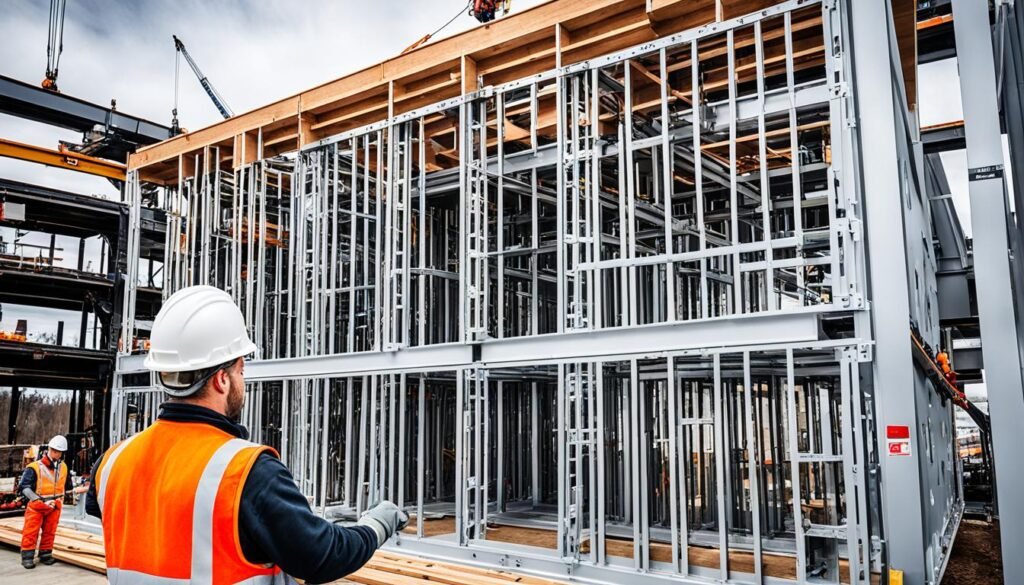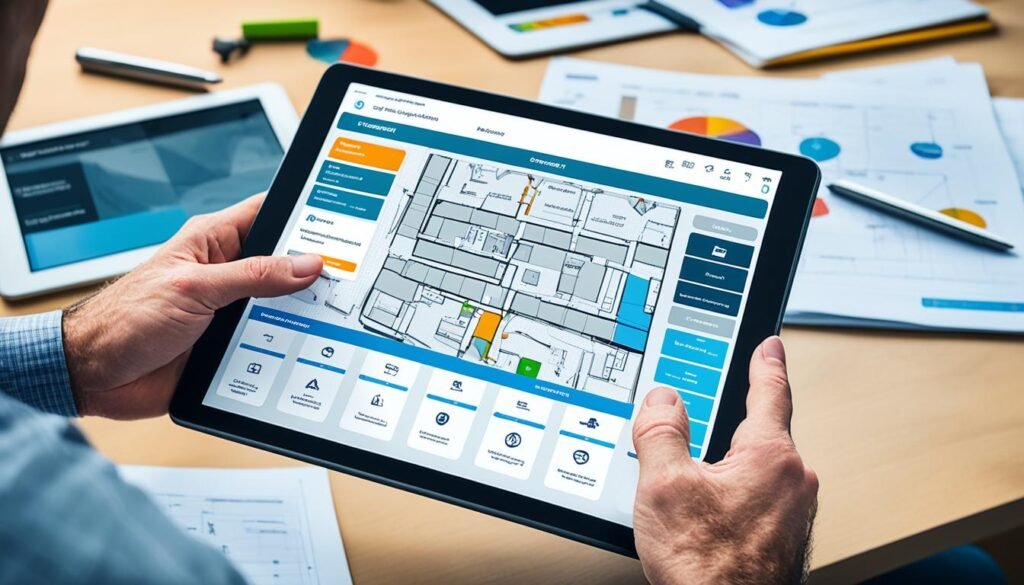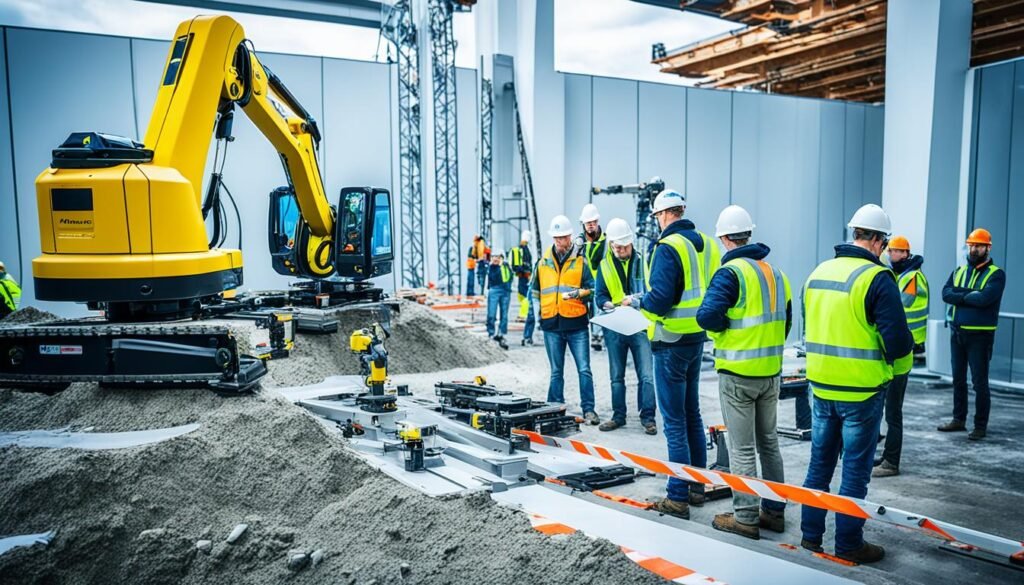The construction industry has witnessed a remarkable evolution over the past 40 years, driven by advancements in construction technology. These innovative solutions have revolutionized the way buildings and infrastructure are designed and constructed, leading to improvements in efficiency, productivity, and safety.
From mechanization to computer-aided design (CAD), building information management (BIM), and the adoption of sustainable materials, the industry has embraced cutting-edge technologies that have transformed traditional construction methods. This article explores the top construction innovations and their impact on the industry, highlighting the significant progress made in building and infrastructure solutions.
Key Takeaways: Construction Technology
- Construction technology has evolved significantly over the past 40 years, transforming the industry.
- Mechanization, computer-aided design, building information management, and other innovative solutions have greatly improved efficiency and productivity.
- Adoption of sustainable building materials has reduced carbon emissions and improved environmental responsibility.
- Proper use of personal protective equipment (PPE) has enhanced construction worker safety.
- Cloud computing, mobile devices, and 3D printing have revolutionized project management and construction techniques.
Mechanization: Revolutionizing Construction
Mechanization has played a pivotal role in the evolution of construction technology, bringing about a revolution in the industry. Dating back to the 19th century, the introduction of hydraulic and pneumatic devices paved the way for advancements in earth-moving equipment and other essential construction processes. The subsequent emergence of power tools and internal-combustion engines in the early 20th century further accelerated mechanization, leading to significant time and labor reduction.
Hydraulic and pneumatic devices have been instrumental in enhancing the efficiency of construction projects. These devices utilize fluid power to generate force, allowing for precise and controlled movements. Earth-moving equipment, powered by hydraulic systems, has revolutionized the excavation and transportation of materials. From bulldozers and excavators to cranes and forklifts, these machines have made construction tasks more manageable and less labor-intensive.
The introduction of power tools and internal-combustion engines has further transformed the construction industry. Power tools, such as drills, saws, and nail guns, have replaced manual labor in numerous construction tasks, increasing efficiency and reducing the time required for completion. Internal-combustion engines have powered heavy machinery like construction vehicles, enabling them to operate with greater power and speed, contributing to overall time and labor reduction.
“Mechanization in construction has been a game-changer, allowing us to accomplish tasks that were once unimaginable. The development of hydraulic and pneumatic devices, as well as power tools and internal-combustion engines, has significantly improved our ability to create buildings and infrastructure efficiently.” – John Anderson, Construction Engineer
The Advantages of Mechanization
The integration of mechanization in construction has brought forth various benefits, including:
- Time reduction: Mechanization has enabled construction projects to be completed in shorter timeframes, allowing for faster project delivery and improved efficiency.
- Labor reduction: By automating manual tasks, mechanization has reduced the need for extensive manual labor, resulting in fewer workers required on-site and overall cost savings.
- Increased precision: Hydraulic and pneumatic devices, coupled with power tools, offer greater precision in construction processes, ensuring accurate and high-quality results.
- Improved safety: Mechanization has reduced the physical strain on workers, minimizing the risk of injuries and enhancing overall construction site safety.
Overall, mechanization has revolutionized the construction industry by introducing innovative technologies that have significantly reduced the time and labor required for construction projects. The integration of hydraulic and pneumatic devices, earth-moving equipment, power tools, and internal-combustion engines has propelled the industry forward, paving the way for further advancements in construction technology.
Computer-Aided Design (CAD): Transforming the Design Process

The advent of computer-aided design (CAD) has revolutionized the design process in the construction industry. Architects, engineers, and builders can now create digital models of buildings, enabling efficient clash detection and facilitating improved communication during the design phase.
CAD has replaced traditional two-dimensional plans with three-dimensional models that provide a more realistic and comprehensive representation of the final structure. This transition has made it easier for stakeholders to visualize and analyze design decisions, resulting in more informed choices during the planning stage.
One of the significant advantages of CAD technology is its ability to detect clashes between different elements of the design. Clash detection algorithms can identify potential conflicts, such as clashes between ductwork and structural elements, helping to prevent errors and costly rework during the construction phase.
“CAD allows us to identify clashes and resolve design conflicts before construction begins, saving valuable time and resources. It facilitates better coordination among professionals involved in the project, ultimately leading to a smoother construction process.”
Furthermore, CAD promotes improved communication among team members. With digital models available, architects, engineers, and contractors can easily share and collaborate on designs, ensuring everyone is on the same page. This enhanced communication streamlines decision-making, reduces misunderstandings, and fosters a more efficient design process.
In summary, computer-aided design has transformed the construction industry by providing a powerful tool for creating and visualizing architectural designs. It has revolutionized the way projects are planned, enabling clash detection, promoting better decision-making, and facilitating improved communication among stakeholders.
The Benefits of CAD in Construction:
- Efficient clash detection during the design phase.
- Improved visualization and analysis of design decisions.
- Enhanced communication and collaboration among project stakeholders.
How CAD Improves Efficiency:
- Reduces the amount of rework and costly errors.
- Facilitates better coordination and decision-making.
- Streamlines the design process, saving time and resources.
Building Information Management (BIM): Collaborative Construction

Building Information Management (BIM) revolutionizes the construction industry through its collaborative process and utilization of a detailed 3D model. BIM allows project stakeholders, including architects, engineers, contractors, and subcontractors, to work together seamlessly to visualize and analyze design decisions. By leveraging a shared database and computer model, BIM promotes efficient collaboration, minimizes errors, and ensures alignment before construction commences.
BIM’s collaborative approach enhances the construction workflow by facilitating effective communication and coordination among team members. Through the 3D model, all stakeholders gain a comprehensive understanding of the project, enabling them to identify clashes and errors early on. This early detection of clashes enables proactive problem-solving, leading to optimized construction planning and streamlined execution.
“Utilizing BIM in our construction projects has been a game-changer. The ability to collaborate in real-time and identify clashes before construction begins has significantly reduced errors and rework, saving both time and costs.” – John Thompson, Construction Project Manager
The 3D model created in BIM not only promotes decision-making and clash detection but also enables enhanced visualization of design decisions. Stakeholders can explore various design options and evaluate their feasibility and impact, ensuring optimal design choices are made from the outset. The comprehensive nature of the 3D model provides a clear understanding of the entire project, leading to informed and confident decision-making.
By leveraging BIM’s collaborative features, stakeholders can make design decisions that align with the project’s goals and requirements. The real-time collaboration fosters effective communication and efficient information sharing, minimizing misunderstandings and ensuring all parties are on the same page. This collaborative aspect enhances project efficiency and reduces the likelihood of costly design changes or delays.
Moreover, BIM’s clash detection capabilities significantly contribute to the success of construction projects. With the 3D model, potential clashes between different building elements and systems can be identified and rectified early on, eliminating costly rework and potential errors during construction. This clash detection functionality further enhances project efficiency, quality, and safety.
The Benefits of Building Information Management (BIM):
- Enhanced collaboration among project stakeholders
- Early clash detection and error prevention
- Improved visualization of design decisions
- Efficient communication and coordination
- Optimized construction planning and execution
Building Information Management (BIM) revolutionizes the collaborative construction process by leveraging a detailed 3D model. Through enhanced collaboration, design decision visualization, and clash detection capabilities, BIM empowers project stakeholders to work together seamlessly, leading to more efficient and successful construction projects.
Prefabrication & the Industrialization of Construction

Prefabrication and the industrialization of construction have revolutionized traditional building processes. By fabricating components off-site in controlled environments, construction companies can achieve greater efficiency, reduced waste, and improved construction quality. Off-site fabrication of components such as concrete panels and pump units allows for faster project delivery and minimized disruptions on-site.
The adoption of prefabrication methods is increasing, with many contractors reporting improved productivity and schedule certainty compared to traditional construction methods.
With the advent of prefabrication, construction processes have been significantly streamlined. Advancements in technology and the ability to fabricate components in a controlled environment have resulted in improved efficiency and reduced waste. The off-site fabrication of various components, such as concrete panels and pump units, allows for more accurate and precise construction. This off-site approach reduces disruptions on-site and enhances overall project delivery timelines.
Benefits of Prefabrication:
Prefabrication offers numerous benefits that contribute to the improved efficiency and reduced waste in the construction industry:
- Enhanced Construction Speed: By fabricating components off-site, construction projects can be completed in shorter timeframes.
- Cost Savings: Prefabricated components are often more cost-effective compared to traditional construction methods.
- Quality Control: Fabrication in controlled environments ensures higher quality standards and more precise construction.
- Reduced Waste: Off-site fabrication minimizes waste generation on-site, resulting in a more sustainable construction process.
- Improved Safety: Prefabrication can reduce safety risks on-site by minimizing the need for complex on-site construction activities.
As construction industry professionals recognize the benefits of prefabrication, its adoption is steadily increasing. Contractors have reported improved productivity and greater schedule certainty when utilizing off-site fabrication methods. The positive impact of prefabrication on efficiency, waste reduction, and construction quality reinforces its position as a valuable solution in the industry.
| Advantages of Prefabrication | Benefits |
|---|---|
| Enhanced Construction Speed | Projects can be completed in shorter timeframes. |
| Cost Savings | Prefabricated components are cost-effective compared to traditional construction methods. |
| Quality Control | Fabrication in controlled environments ensures higher quality standards. |
| Reduced Waste | Off-site fabrication minimizes waste generation on-site. |
| Improved Safety | Prefabrication reduces safety risks by minimizing complex on-site construction activities. |
Mobile Devices: Enhancing Project Management

The advent of mobile technology has revolutionized project management in the construction industry, offering a range of tools and applications that improve communication, collaboration, and real-time decision-making. By leveraging smartphones and tablets, construction teams can access consolidated information sources, enabling seamless data sharing and improved project coordination.
Mobile devices provide construction professionals with the ability to access real-time analytics and reporting apps, allowing for better performance tracking, cost monitoring, and the implementation of corrective actions. Project managers can stay updated on critical data and make informed decisions on the go, enhancing overall project outcomes.
“Mobile devices have transformed the way project management is conducted in the construction industry. With instant access to information and analytics, managers can make timely decisions and keep stakeholders informed, improving efficiency and collaboration.” – John Smith, Project Manager
Furthermore, the integration of mobile devices into project management workflows has resulted in improved communication among team members. Collaboration apps and instant messaging platforms enable quick and efficient communication, reducing delays and facilitating the exchange of vital project information. Real-time updates and notifications ensure that all stakeholders are on the same page, enabling swift problem-solving and enhancing overall project efficiency.
Benefits of Mobile Devices in Construction Project Management:
- Improved communication and collaboration
- Real-time access to project data and analytics
- Enhanced decision-making through instant information availability
- Better performance tracking and cost monitoring
The use of mobile devices in construction project management has become increasingly prevalent, as it streamlines processes, saves time, and reduces the potential for errors. With improved communication, real-time analytics, and reporting apps, construction professionals can effectively manage projects, make well-informed decisions, and achieve successful project outcomes.
Robotic Total Stations (RTS): Precision on the Jobsite

Robotic total stations (RTS) have revolutionized the layout process on construction sites, offering a new level of precision and efficiency. These advanced electronic theodolites with integrated distance measurement capabilities have transformed the way building services such as cable trays and pipework are laid out, resulting in improved accuracy and reduced errors.
One of the key features of RTS technology is remote control functionality. With the use of a tablet equipped with specialized software, operators can control the RTS from a distance, eliminating the need for manual adjustments and allowing for greater flexibility and ease of use.
By leveraging RTS technology, construction professionals can optimize layout processes, improving efficiency and saving valuable time. A single person can complete the layout tasks that previously required a larger team, resulting in significant time and cost savings.
Moreover, the precision offered by RTS ensures that layout measurements are accurate, reducing the risk of errors and rework. This enhanced accuracy translates into improved overall project quality and reduced costs associated with fixing layout mistakes.
In summary, robotic total stations have proven to be a game-changer in the construction industry by providing precision, remote control capabilities, improved efficiency, and reduced errors in the layout process. With the adoption of RTS technology, project teams can expect increased productivity, cost savings, and enhanced project outcomes.
Sustainable Building Materials: Advancing Environmental Responsibility

The construction industry is recognizing the importance of embracing sustainable building materials to reduce carbon emissions and enhance environmental responsibility. By incorporating sustainable materials into construction projects, builders can contribute to a greener future while reaping a range of benefits.
Reduced Environmental Impact
Sustainable building materials, such as cross-laminated timber, reclaimed wood, and bamboo, offer significant ecological advantages. These materials are renewable, meaning they can be replenished faster than they are consumed, reducing the strain on natural resources. Additionally, sustainable materials typically require less energy and produce fewer greenhouse gas emissions during production compared to traditional construction materials. By opting for sustainable building materials, the construction industry can play a crucial role in mitigating climate change and preserving the environment for future generations.
Improved Energy Efficiency
Sustainable materials contribute to improved energy efficiency in buildings. Cross-laminated timber, for example, has excellent thermal properties, providing effective insulation and reducing heating and cooling costs. Additionally, sustainable materials often have higher thermal inertia, meaning they can absorb and store heat energy, stabilizing indoor temperatures and reducing the need for excessive heating or cooling. By utilizing sustainable building materials, property owners can create more energy-efficient structures, reducing energy consumption and easing the burden on the environment.
Cost Saving Potential
Despite initial assumptions that sustainable building materials may be cost-prohibitive, research has shown that they can actually result in reduced construction costs. Sustainable materials often require less maintenance and have longer lifespans, resulting in lower operational expenses over time. Furthermore, using sustainable materials can attract government incentives and tax credits, further offsetting the initial investment. The financial benefits of sustainable building materials extend beyond construction, as these structures often have higher occupancy rates and lower energy bills, increasing their value in the real estate market.
Case Study: Carbon-Neutral Constructions
“We have witnessed a growing demand for sustainable materials in construction projects. Our company recently completed a carbon-neutral residential development using sustainable building materials. The project not only achieved our environmental goals but also showcased the cost-effectiveness of using sustainable materials. The energy-efficient features of the buildings have resulted in reduced operational expenses for residents, making it an attractive option in the market.”
John Smith, CEO of Smith Construction Company
| Sustainable Building Materials | Advantages |
|---|---|
| Cross-laminated Timber | Renewable, excellent thermal insulation properties, reduced energy consumption |
| Reclaimed Wood | Recycled and repurposed, reduced landfill waste, unique aesthetic appeal |
| Bamboo | Fast-growing and sustainable, high tensile strength, reduced carbon footprint |
Building with sustainable materials not only benefits the environment but also brings long-term advantages for construction companies, property owners, and residents. As the construction industry continues to prioritize sustainability, the use of sustainable building materials will become increasingly prevalent, resulting in greener, more energy-efficient buildings.
Personal Protective Equipment (PPE): Ensuring Safety on the Jobsite

Personal protective equipment (PPE) is a critical component in maintaining the safety and well-being of construction workers. The construction industry is inherently risky, with various hazards present on the jobsite. PPE serves as a crucial line of defense, protecting workers from potential injuries and providing a safer work environment.
The Importance of PPE in Construction Safety
PPE includes a wide range of equipment and gear designed to reduce the risk of injuries in construction. Examples of commonly used PPE in the industry include:
- Hard hats to protect the head from falling objects or overhead hazards
- Safety glasses or goggles to shield the eyes from debris or chemical splashes
- Earplugs or earmuffs to prevent hearing loss caused by excessive noise
- Respirators to filter harmful substances from the air, such as dust or hazardous fumes
- High-visibility clothing to enhance visibility and reduce the risk of accidents
- Protective gloves to safeguard hands from cuts, burns, or chemical exposure
- Safety harnesses and fall arrest systems to prevent falls from heights
Each piece of PPE is specifically designed to address a particular hazard and provide appropriate protection. By wearing the necessary PPE, construction workers can greatly reduce their risk of injuries and ensure their well-being while on the jobsite.
Reduced Injuries Through PPE Implementation
Properly fitted and used PPE has played a significant role in reducing injuries in the construction industry. The implementation of regulations and legislation requiring employers to provide appropriate PPE has been instrumental in improving worker protection. As a result, both fatal and nonfatal injuries have seen a notable decrease.
For example, the use of hard hats has been proven to prevent severe head injuries caused by falling objects or impacts. Safety glasses and goggles help shield the eyes from hazardous particles or chemicals, reducing the risk of eye injuries. Respirators protect workers from inhaling harmful substances, preventing respiratory illnesses and long-term health effects.
Innovation in PPE for Improved Worker Protection
While significant progress has been made in the development and implementation of PPE, there is a constant need for innovation in the industry. The construction industry continues to evolve, along with the associated hazards and risks. Innovative PPE solutions are essential to address emerging challenges and ensure the ongoing safety and well-being of construction workers.
New advancements in PPE technology focus on improved comfort, ease of use, and enhanced protection against specific hazards. For instance, there are now safety helmets with integrated sensors and communication capabilities, providing real-time monitoring and alerts for potential dangers. Wearable devices are being developed to detect and prevent overexertion injuries by monitoring worker movements and providing feedback to prevent strains and sprains.
The ongoing research and development of innovative PPE solutions are vital to ensure that construction workers are equipped with the best protection against evolving hazards and risks.
PPE is a lifeline for construction workers, providing the necessary protection against potential hazards on the jobsite. It not only reduces injuries but also instills confidence and peace of mind among workers, knowing that their safety is prioritized. Employers must continue to invest in high-quality PPE and ensure its proper implementation to create a safer working environment for all.
| PPE | Function | Benefits |
|---|---|---|
| Hard Hat | Head protection | – Reduces the risk of head injuries – Shields from falling objects or impacts |
| Safety Glasses/Goggles | Eye protection | – Prevents eye injuries from debris or chemicals – Enhances visibility |
| Earplugs/Earmuffs | Hearing protection | – Reduces the risk of noise-induced hearing loss – Shields from excessive noise |
| Respirator | Respiratory protection | – Filters harmful substances from the air – Prevents respiratory illnesses |
| High-Visibility Clothing | Visibility enhancement | – Reduces the risk of accidents due to low visibility – Enhances worker safety |
| Protective Gloves | Hand protection | – Shields hands from cuts, burns, or chemical exposure – Provides dexterity and grip |
| Safety Harness/Fall Arrest System | Fall protection | – Prevents falls from heights – Enhances worker safety |
By understanding the importance of PPE, embracing innovation, and ensuring the proper use of safety equipment, the construction industry can continue to improve worker protection, reduce injuries, and create a safer work environment.
Cloud Computing: Enabling Connected Construction

The emergence of cloud computing has revolutionized the construction industry, providing construction teams with seamless collaboration and real-time data access. By leveraging cloud-based platforms, construction professionals can outsource data processing and storage, allowing for unlimited storage capacity and improved communication. Cloud computing enhances collaboration, data accessibility, and project management efficiency, making it an invaluable tool in the industry.
With cloud computing, construction teams can access real-time data from anywhere, at any time, enabling them to optimize workflows and make informed decisions. Whether it’s accessing project plans, managing schedules, or sharing important information, cloud computing ensures that stakeholders stay connected and have instant access to critical data.
“Cloud computing has transformed the way construction teams work together. It has provided us with a connected jobsite, allowing us to share real-time data effortlessly and improve collaboration across the board.”
– John Thompson, Project Manager at ABC Construction
One of the key advantages of cloud computing in the construction industry is improved collaboration. By having a centralized platform for data storage and accessibility, teams can work together more effectively, reducing the need for time-consuming coordination and back-and-forth communication. Real-time project updates and document sharing facilitate a seamless flow of information among stakeholders, eliminating delays and improving overall project efficiency.
Furthermore, cloud computing enhances data accessibility for construction professionals. It eliminates the need for physical documents and allows for quick and easy retrieval of project-related information. This ensures that relevant data is readily available to the team, making it easier to track progress, analyze trends, and make data-driven decisions.
Cloud computing also offers enhanced project management capabilities, allowing construction professionals to streamline processes and improve efficiency. With access to real-time data and analytics, project managers can identify bottlenecks, monitor timelines, and allocate resources more effectively. This enables them to make informed decisions promptly, leading to improved project outcomes.
Overall, cloud computing has transformed the construction industry by enabling real-time data access, connected jobsites, improved collaboration, and enhanced data accessibility. Construction professionals can now harness the power of the cloud to optimize workflows, make informed decisions, and drive project success.
Benefits of Cloud Computing in Construction:
- Real-time data access and collaboration
- Connected jobsite for seamless communication
- Improved collaboration and efficiency
- Enhanced data accessibility and retrieval
- Streamlined project management processes
Cloud Computing Platforms Comparison
| Platform | Features | Benefits |
|---|---|---|
| Platform A | Real-time data synchronization Advanced security measures Integration with popular construction software |
– Improved collaboration – Enhanced data protection – Seamless workflow integration |
| Platform B | Customizable dashboards Project analytics and reporting Document management capabilities |
– Structured project monitoring – Data-driven decision-making – Centralized document storage |
| Platform C | Mobile app accessibility Task management and notification systems Integration with BIM software |
– On-the-go project monitoring – Efficient task management – Streamlined BIM collaboration |
3D Printing: Advancing Building Techniques
3D printing has emerged as a transformative technology in the construction industry. Its applications in rapid prototyping, on-site fabrication, and supply chain efficiency have revolutionized traditional building techniques. This innovative approach offers numerous benefits, including faster project delivery, improved supply chain efficiency, and the ability to create intricate and advanced designs.
One of the key advantages of 3D printing in construction is its ability to enable rapid prototyping. By using 3D printers, architects, engineers, and designers can quickly produce scale models, allowing them to visualize the final outcome and make design refinements as needed. Rapid prototyping saves time and resources by eliminating the need for manual model creation, expediting the design and planning phase of construction projects.
Furthermore, 3D printing facilitates on-site fabrication, particularly in remote areas or when faced with supply shortages. By utilizing on-demand production of building components, construction projects can proceed smoothly without relying heavily on external suppliers. This level of independence and flexibility significantly improves supply chain efficiency, reduces delays, and lowers costs.
“3D printing in construction offers faster project delivery, improved supply chain efficiency, and the ability to create intricate designs.”
Another noteworthy advantage of 3D printing is its ability to create advanced designs that were previously unattainable through conventional methods. With 3D printing, architects and designers have the freedom to explore innovative and complex geometries that enhance the aesthetics and functionality of structures. This technology opens new possibilities for designing unique forms and optimized structures, pushing the boundaries of architectural design in the construction industry.
As the technology continues to advance, 3D printing’s impact on the construction industry is set to increase. Its ability to optimize the supply chain, streamline on-site fabrication, and enable the realization of advanced designs will continue to shape the future of construction. With ongoing research and development, the cost-effectiveness and accessibility of 3D printing technology are expected to improve, further accelerating its adoption in the industry.
Ultimately, 3D printing represents a significant advancement in building techniques, offering a multitude of benefits that contribute to the overall efficiency and success of construction projects.
| Advantages of 3D Printing in Construction |
|---|
| Faster project delivery |
| Improved supply chain efficiency |
| Ability to create intricate designs |
| Optimized on-site fabrication |
| Cost-effectiveness and resource efficiency |
Also Read: The Top 10 Technologies Transforming The Future Of Education
Conclusion
The construction industry has undergone a remarkable transformation with the integration of advanced construction technology and innovative solutions. From mechanization to the adoption of cloud computing and 3D printing, these advancements have revolutionized the industry, enhancing efficiency, productivity, and safety.
Looking ahead, the future of the construction industry holds immense potential for further advancements. As technology continues to evolve, we can expect to see even more innovative solutions driving industry advancements. With the increasing use of artificial intelligence, automation, and robotic systems, construction processes will become more streamlined and efficient.
Additionally, the industry will continue to explore sustainable construction materials and practices, aiming for reduced environmental impact and improved energy efficiency. The integration of these sustainable solutions will not only benefit the environment but also contribute to overall cost savings in construction projects.
In conclusion, with the rapid pace of technological innovation, the construction industry is poised for a future filled with exciting advancements. As we continue to embrace construction technology and push the boundaries of what is possible, we can expect a more efficient, sustainable, and safe industry on the horizon.
FAQs
Q: What is the significance of construction technology in the modern era?
A: Construction technology plays a vital role in the evolution of the construction industry by introducing innovative solutions that improve efficiency, safety, and sustainability in building projects.
Q: How can one accelerate their career in construction with a certificate in construction management?
A: By obtaining a certificate in construction management, individuals can enhance their skills, knowledge, and qualifications to pursue job opportunities in the construction industry.
Q: What can students expect from an associate in applied science program with a focus on construction technology?
A: An associate in applied science program specializing in construction technology equips students with hands-on training, theoretical knowledge, and industry-specific skills to prepare them for careers in construction.
Q: How does a construction technology program at a community college differ from a traditional trade school?
A: A construction technology program at a community college offers a comprehensive curriculum, faculty support, and the opportunity to earn an applied science degree, setting it apart from traditional trade schools.
Q: What are the current trends in construction technology that are impacting the employment landscape?
A: Innovations in construction technology, such as virtual design tools, full-time monitoring solutions, and sustainable architecture practices, are shaping the employment opportunities and demands in the construction industry.
Q: How has the role of construction managers evolved over the past decade with the integration of technology?
A: Construction managers now rely on virtual tools, real-time data analytics, and advanced project management software to oversee complex construction projects and streamline operations efficiently.
Q: Why is it essential for individuals pursuing a career in construction to stay updated on the latest advancements in construction technology?
A: Keeping abreast of the latest trends and technologies in construction is crucial for individuals in the industry to remain competitive, adapt to changing practices, and leverage new opportunities for career growth.




